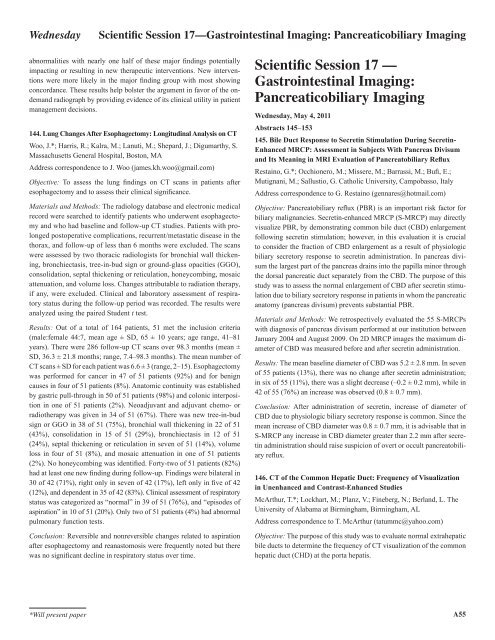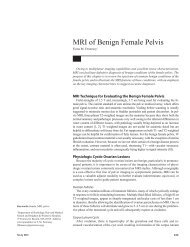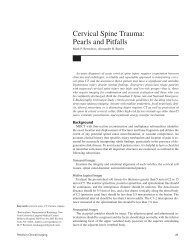<strong>Scientific</strong> <strong>Session</strong> 16—Cardiopulmonary <strong>Imaging</strong>: ChestWednesdaywhole chest CT angiography for cardiac surgery involve significant radiationexposure. Combined techniques using higher dose techniques of thecoronary arteries while decreasing radiation dose for the remainder of thechest may require repeated contrast dose administrations or scan delaysresulting in suboptimal imaging quality. We describe our experience usingaggressive dose reduction techniques to provide diagnostic information forcardiac surgical planning while significantly reducing the need for invasivecoronary angiography for this important patient population.Materials and Methods: Forty-two patients underwent low-dose chest CTfor preoperative surgical planning (26 male, 16 female). Thirty-five patientswere undergoing evaluation for aortic valve replacement and five were undergoingmitral valve surgery, while two were undergoing aortic aneurysmresection. All patients were evaluated using a dual-source 64-slice CT with330-ms rotation time and 83-ms temporal resolution. Scan techniques weredetermined by body mass index (BMI): in patients with BMI less than 30,100 kV was utilized, 120 kV used for patients with BMI greater than 30.Dose modulation techniques were used, with 250 effective mAs. All examinationswere performed using prospective ECG gating. Oral β-blockerswere used in patients with resting heart rates greater than 70 beats/min.Results: Thirty-five patients had the procedure performed using a 100-kVtechnique (mean dose, 3.0 mSv). Seven patients were imaged with 120kV (mean dose, 5.3 mSv). All examinations were diagnostic for evaluationof sternal, chest wall, and cardiac anatomy. Thirty-one (74%) of 42CT examinations were of diagnostic quality for exclusion of coronaryartery disease. Eleven examinations of 42 patients (26%) were nondiagnosticfor coronary artery evaluation.Conclusion: CT techniques provide important cardiac surgical informationwhile precluding invasive coronary angiography. Aggressive dosereduction technologies enabled important diagnostic information with50% dose reduction when compared with standard imaging techniques.142. Subjective Perception of Image Noise and Lesion Conspicuityin Low-Dose Chest MDCT ProtocolsGalizia, M. 1 *; Patel, S. 1 ; Grant, T. 1 ; Harmath, C. 1 ; Kino, A. 1 ; Juliano,A. 2 ; Hart, E. 1 ; Yaghmai, V. 1 1. Northwestern University-Feinberg Schoolof Medicine, Chicago, IL; 2. No Institutional AffiliationAddress correspondence to V. Yaghmai (v-yaghmai@northwestern.edu)Objective: To determine if different observers are able to subjectivelyassess the degree of noise and the conspicuity of lesions when a low-doseprotocol is used for pulmonary examinations by MDCT.Materials and Methods: A thoracic phantom that simulates several alterationswas scanned by MDCT with 1.2-mm collimation, 28-cm field ofview, 100 kV, and four different values for mAs (40 mAs, 60 mAs, 80 mAs,100 mAs). The data were reconstructed into two different combinations ofslice thickness and spacing: 5.0 × 5.0 mm and 3.0 × 1.5 cm. The image setswere showed to six independent radiologists, three trained as chest subspecialistsand three trained in other subspecialties. The radiologists wereasked to grade, on a scale from 1 to 5, the degree of general noise in theimages and the conspicuity of two different lesions (one nodule and onetree-in-bud pattern). Several coefficients of correlation between the mAsused in the studies and the grades given by the radiologists were calculatedand compared. Significance was defined as p < 0.05.Results: There was a moderate correlation between the mAs used in thestudies and the degree of noise assessed by the radiologists (r = 0.49).When data were divided in two groups by the criteria of type of reconstructionand radiologist’s subspecialty, there were no significant differencesbetween the two correlation coefficients (p = 0.23 and p = 0.35,respectively). There was also a moderate correlation between mAs andthe conspicuity of the alterations as subjectively graded by the observers(r = 0.37). When data were divided in two groups by the criteria ofradiologist’s subspecialty, there was no difference between the two correlationcoefficients (p = 0.63).Conclusion: It is difficult for radiologists to subjectively differentiate thedegree of noise in low-dose chest MDCT. The subjective perception ofthe conspicuity of lesions does not change, regardless of the thickness ofthe slice reconstruction and of the observer’s subspecialty.143. On-Demand Chest Radiographs for Hypoxia: Impact onClinical CareWalker, C.*; Tang, J.; Richardson, M.; Stern, E. University ofWashington, Kent, WAAddress correspondence to C. Walker (walk0060@u.washington.edu)Objective: To determine the therapeutic yield of on-demand chest radiographsin the setting of hypoxia and the accuracy of indications listed onthe clinical requisition forms.Materials and Methods: Institutional review board approval was obtained,and a retrospective study was performed examining all ICU patientsin a level 1 trauma center over a 2.5-year period. Subjects wereincluded only if comparison radiographs were obtained while the patientwas intubated and the word hypoxia or an equivalent alternative waslisted in the requisition. Accuracy of the requisition was determined byreviewing the electronic medical record (EMR). Findings in the radiographreports were categorized into three groups—no change, minor newfinding, or major new finding. Studies were not reinterpreted. A majornew finding was defined as one that could result in additional medicalmanagement. An example would include a new or increasing pneumothorax.Therapeutic yield was defined as any new clinical interventiondocumented in the EMR occurring within the proximate timeframe afterperformance of the on-demand radiograph. Interventions were recordedas concordant or discordant to the expected therapy for the correspondingradiographic abnormalities. An example of concordance includes chesttube placement for a pneumothorax.Results: Six hundred seventy-six studies performed on 506 patients werestudied. Ninety-six percent of requisitions matched recorded clinicaldocumentation. Fifty-five percent, 20%, and 24% of the radiographicfindings were categorized into the no change, minor new finding, andmajor new finding groups, respectively. New or increasing pneumothoraxrepresented 25% of the major new findings. A major radiographicfinding was more likely to have new interventions compared with a nochange radiograph (odds ratio, 6.44 [4.16–9.78]). The majority of newinterventions were concordant with radiographic findings, with only 7%of studies showing discordance.Conclusion: Most reported clinical indications were accurate. Ondemandradiographs performed for hypoxia yield a high percentage ofA54*Will present paper
Wednesday<strong>Scientific</strong> <strong>Session</strong> 17—Gastrointestinal <strong>Imaging</strong>: Pancreaticobiliary <strong>Imaging</strong>abnormalities with nearly one half of these major findings potentiallyimpacting or resulting in new therapeutic interventions. New interventionswere more likely in the major finding group with most showingconcordance. These results help bolster the argument in favor of the ondemandradiograph by providing evidence of its clinical utility in patientmanagement decisions.144. Lung Changes After Esophagectomy: Longitudinal Analysis on CTWoo, J.*; Harris, R.; Kalra, M.; Lanuti, M.; Shepard, J.; Digumarthy, S.Massachusetts General Hospital, Boston, MAAddress correspondence to J. Woo (james.kh.woo@gmail.com)Objective: To assess the lung findings on CT scans in patients afteresophagectomy and to assess their clinical significance.Materials and Methods: The radiology database and electronic medicalrecord were searched to identify patients who underwent esophagectomyand who had baseline and follow-up CT studies. Patients with prolongedpostoperative complications, recurrent/metastatic disease in thethorax, and follow-up of less than 6 months were excluded. The scanswere assessed by two thoracic radiologists for bronchial wall thickening,bronchiectasis, tree-in-bud sign or ground-glass opacities (GGO),consolidation, septal thickening or reticulation, honeycombing, mosaicattenuation, and volume loss. Changes attributable to radiation therapy,if any, were excluded. Clinical and laboratory assessment of respiratorystatus during the follow-up period was recorded. The results wereanalyzed using the paired Student t test.Results: Out of a total of 164 patients, 51 met the inclusion criteria(male:female 44:7, mean age ± SD, 65 ± 10 years; age range, 41–81years). There were 286 follow-up CT scans over 98.3 months (mean ±SD, 36.3 ± 21.8 months; range, 7.4–98.3 months). The mean number ofCT scans ± SD for each patient was 6.6 ± 3 (range, 2–15). Esophagectomywas performed for cancer in 47 of 51 patients (92%) and for benigncauses in four of 51 patients (8%). Anatomic continuity was establishedby gastric pull-through in 50 of 51 patients (98%) and colonic interpositionin one of 51 patients (2%). Neoadjuvant and adjuvant chemo- orradiotherapy was given in 34 of 51 (67%). There was new tree-in-budsign or GGO in 38 of 51 (75%), bronchial wall thickening in 22 of 51(43%), consolidation in 15 of 51 (29%), bronchiectasis in 12 of 51(24%), septal thickening or reticulation in seven of 51 (14%), volumeloss in four of 51 (8%), and mosaic attenuation in one of 51 patients(2%). No honeycombing was identified. Forty-two of 51 patients (82%)had at least one new finding during follow-up. Findings were bilateral in30 of 42 (71%), right only in seven of 42 (17%), left only in five of 42(12%), and dependent in 35 of 42 (83%). Clinical assessment of respiratorystatus was categorized as “normal” in 39 of 51 (76%), and “episodes ofaspiration” in 10 of 51 (20%). Only two of 51 patients (4%) had abnormalpulmonary function tests.Conclusion: Reversible and nonreversible changes related to aspirationafter esophagectomy and reanastomosis were frequently noted but therewas no significant decline in respiratory status over time.<strong>Scientific</strong> <strong>Session</strong> 17 —Gastrointestinal <strong>Imaging</strong>:Pancreaticobiliary <strong>Imaging</strong>Wednesday, May 4, 2011Abstracts 145-153145. Bile Duct Response to Secretin Stimulation During Secretin-Enhanced MRCP: Assessment in Subjects With Pancreas Divisumand Its Meaning in MRI Evaluation of Pancreatobiliary RefluxRestaino, G.*; Occhionero, M.; Missere, M.; Barrassi, M.; Bufi, E.;Mutignani, M.; Sallustio, G. Catholic University, Campobasso, ItalyAddress correspondence to G. Restaino (gennares@hotmail.com)Objective: Pancreatobiliary reflux (PBR) is an important risk factor forbiliary malignancies. Secretin-enhanced MRCP (S-MRCP) may directlyvisualize PBR, by demonstrating common bile duct (CBD) enlargementfollowing secretin stimulation; however, in this evaluation it is crucialto consider the fraction of CBD enlargement as a result of physiologicbiliary secretory response to secretin administration. In pancreas divisumthe largest part of the pancreas drains into the papilla minor throughthe dorsal pancreatic duct separately from the CBD. The purpose of thisstudy was to assess the normal enlargement of CBD after secretin stimulationdue to biliary secretory response in patients in whom the pancreaticanatomy (pancreas divisum) prevents substantial PBR.Materials and Methods: We retrospectively evaluated the 55 S-MRCPswith diagnosis of pancreas divisum performed at our institution betweenJanuary 2004 and August 2009. On 2D MRCP images the maximum diameterof CBD was measured before and after secretin administration.Results: The mean baseline diameter of CBD was 5.2 ± 2.8 mm. In sevenof 55 patients (13%), there was no change after secretin administration;in six of 55 (11%), there was a slight decrease (–0.2 ± 0.2 mm), while in42 of 55 (76%) an increase was observed (0.8 ± 0.7 mm).Conclusion: After administration of secretin, increase of diameter ofCBD due to physiologic biliary secretory response is common. Since themean increase of CBD diameter was 0.8 ± 0.7 mm, it is advisable that inS-MRCP any increase in CBD diameter greater than 2.2 mm after secretinadministration should raise suspicion of overt or occult pancreatobiliaryreflux.146. CT of the Common Hepatic Duct: Frequency of Visualizationin Unenhanced and Contrast-Enhanced StudiesMcArthur, T.*; Lockhart, M.; Planz, V.; Fineberg, N.; Berland, L. TheUniversity of Alabama at Birmingham, Birmingham, ALAddress correspondence to T. McArthur (tatummc@yahoo.com)Objective: The purpose of this study was to evaluate normal extrahepaticbile ducts to determine the frequency of CT visualization of the commonhepatic duct (CHD) at the porta hepatis.*Will present paperA55
















